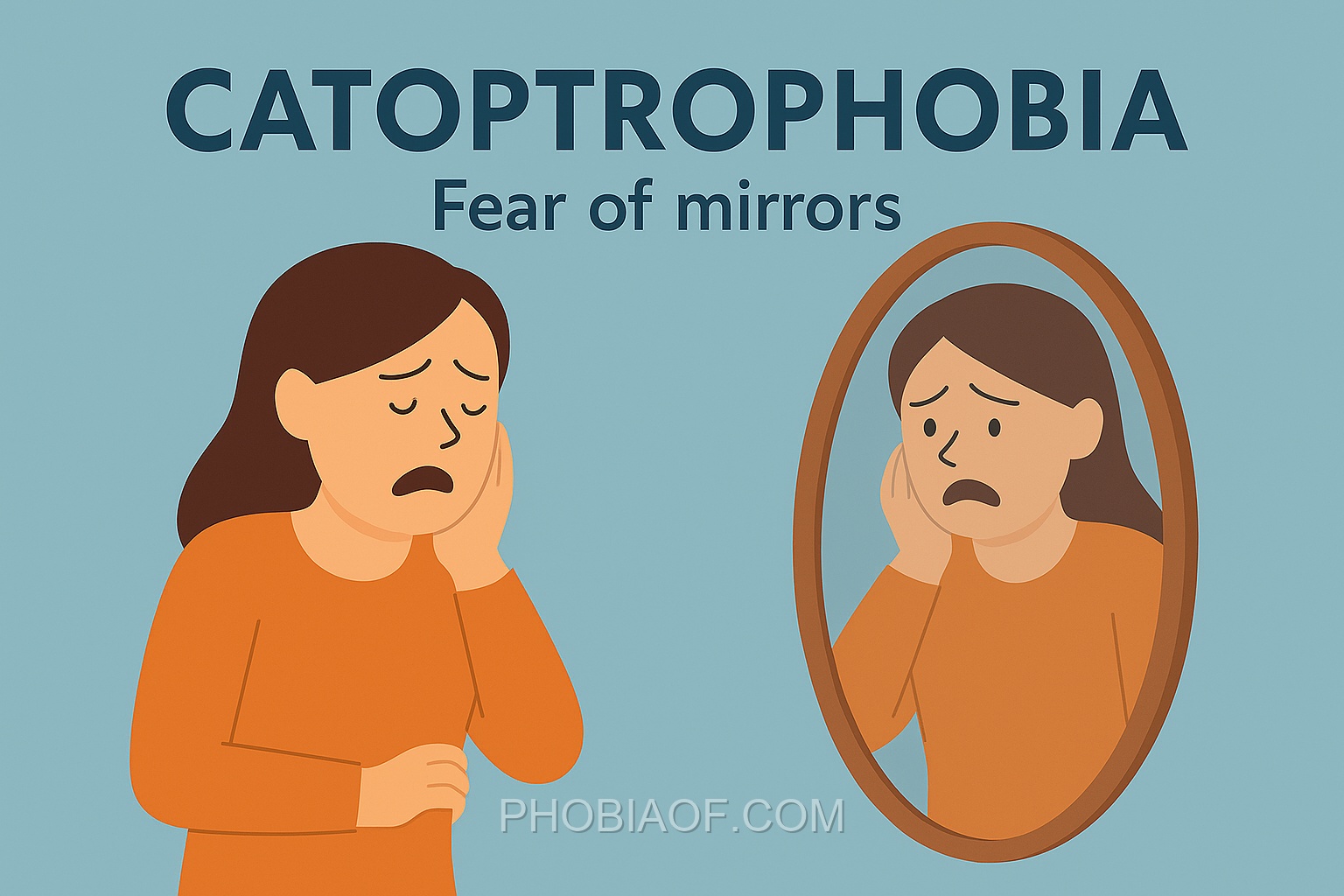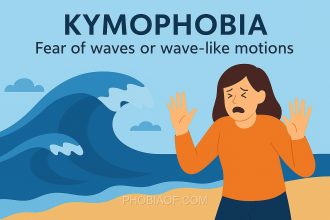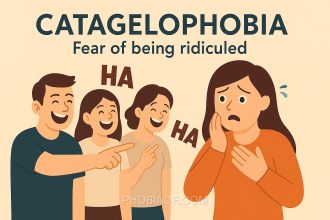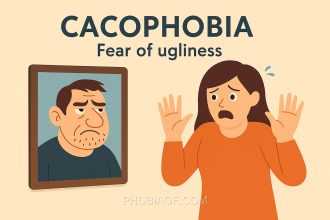Have you ever felt uneasy looking into a mirror, as if the reflection might reveal something more than just your image? This feeling might be more common than you think. Welcome to the world of Catoptrophobia, the fear of mirrors.
Catoptrophobia is derived from the Greek words “katoptron,” meaning mirror, and “phobos,” meaning fear. It describes an intense and irrational fear of mirrors or seeing one’s reflection. For those affected by this phobia, mirrors aren’t just everyday objects—they can evoke significant anxiety and discomfort.
People experiencing catoptrophobia may avoid mirrors entirely, or they might only feel comfortable glancing at them briefly. The fear can manifest in various ways, such as anxiety about reflections, superstition about mirrors holding supernatural power, or distress from distorted self-image.
Understanding and empathizing with such fears is crucial, as they can significantly impact daily life. Here are a few ways catoptrophobia might affect someone:
- Aversion to being in rooms with mirrors
- Avoidance of personal grooming or self-reflection activities
- General anxiety or distress when confronted with mirrors
- Feelings of unease or panic in situations involving mirrors, such as department store fitting rooms
While it might seem unusual to some, catoptrophobia is a legitimate and challenging phobia for those who live with it. Understanding the roots and effects of this fear can foster greater empathy and support for individuals facing this unique challenge.
Causes of Catoptrophobia
Catoptrophobia, the fear of mirrors, can arise from various causes. Understanding these potential causes is essential for both sufferers and those who support them. Here, we explore some of the common reasons why someone might develop this unusual phobia.
- Genetic Predisposition:
Some individuals may have a genetic tendency towards anxiety disorders, including specific phobias like catoptrophobia. If a family member has a similar fear or another anxiety-related condition, it might increase the likelihood of developing such a phobia.
- Traumatic Experiences:
A negative or frightening experience involving mirrors during childhood or at any point in life can trigger catoptrophobia. This could be an event where mirrors were associated with a frightening reflection or an unsettling situation.
- Learned Behavior:
Observing someone else’s fear or negative reaction to mirrors can lead to learned behavior. Children, in particular, might adopt similar fears if they see significant adults or peers reacting anxiously around mirrors.
- Psychological Factors:
Other psychological issues, such as body dysmorphic disorder, might contribute to the development of catoptrophobia. In such cases, individuals perceive mirrors as amplifiers of their insecurities, leading to fear.
- Environmental Factors:
Cultural beliefs and superstitions surrounding mirrors can also play a role. In some cultures, mirrors are believed to be portals to other worlds or to reflect one’s soul, which can instill fear.
Research into catoptrophobia is still evolving, but these factors highlight the complexity of its origins. Addressing the fear often involves understanding these underlying causes, allowing for more effective therapeutic approaches.
Symptoms of Catoptrophobia
Catoptrophobia, the fear of mirrors, can provoke intense fear or anxiety in those who suffer from it. This phobia can manifest in various physical and emotional symptoms that can impact a person’s well-being. Recognizing these symptoms can help in identifying the phobia and seeking appropriate support or treatment.
Physical Symptoms:
- Panic attacks characterized by an overwhelming sense of terror or fear.
- Excessive sweating, especially when near or thinking about mirrors.
- Rapid heartbeat and palpitations, often triggered by mirror exposure.
- Shortness of breath or difficulty breathing when confronted with mirrors.
- Feeling dizzy or lightheaded, particularly in environments with many mirrors.
- Nausea or stomach discomfort when thinking about or seeing mirrors.
Emotional and Behavioral Symptoms:
- Avoidance of places or situations where mirrors are present, such as bathrooms or dressing rooms.
- Overwhelming dread or intense distress at the thought of seeing a mirror.
- Feeling the need to cover or remove mirrors in personal spaces.
- Persistent worry or obsessive thoughts about mirrors or reflections.
- Difficulty concentrating or focusing due to constant anxiety about encountering mirrors.
When catoptrophobia is severe, these symptoms can significantly interfere with daily life, making it challenging to engage in routine activities or maintain a sense of normalcy.
Treatment for Fear of Mirrors
Catoptrophobia, or the fear of mirrors, can be a challenging experience, but it’s important to remember that this phobia can be treated and managed over time. There are several effective treatment options and coping strategies available that can help you overcome your fear and improve your quality of life.
Therapeutic Approaches
Therapy is a highly effective way to address catoptrophobia. Some proven therapies include:
- Exposure Therapy: This involves gradually facing your fear in a controlled and safe environment. By starting with less intimidating situations and slowly working towards more challenging scenarios, you can desensitize yourself to the fear of mirrors.
- Cognitive-Behavioral Therapy (CBT): CBT helps change the fearful thoughts and beliefs associated with mirrors. By identifying and challenging negative thought patterns, you can learn to develop healthier responses to your fear.
- Counseling: Talking to a mental health professional can provide support and guidance. Counseling can help you understand the root causes of your phobia and work through any underlying issues.
Coping Strategies
In addition to therapy, there are several self-help techniques that can complement your treatment:
- Relaxation Exercises: Techniques such as deep breathing, progressive muscle relaxation, and visualization can help reduce anxiety and promote calmness.
- Meditation: Regular meditation practice can help you develop mindfulness and decrease overall anxiety levels.
- Support Groups: Joining a support group can connect you with others who understand your experience. Sharing feelings and strategies can be incredibly validating and empowering.
Medication
In severe cases, medication such as anti-anxiety drugs may be prescribed by a healthcare professional. However, it is generally recommended to focus on therapy and coping skills as primary treatment methods.
It’s essential to seek professional help if catoptrophobia is interfering with your daily life. A mental health expert can provide a tailored treatment plan to address your specific needs. Remember, overcoming a phobia is a journey, but with the right support and strategies, you can manage and eventually conquer your fear of mirrors.
Conclusion
Understanding the causes and symptoms of catoptrophobia can be a powerful first step toward overcoming this fear. By recognizing the triggers and the ways in which this phobia manifests, individuals can begin to take control of their experiences and reduce the fear’s impact on their lives.
It’s important to remember that many people successfully manage or overcome their phobias with time, patience, and the right support. Whether through self-help strategies, therapy, or conversations with a healthcare professional, there are numerous pathways to finding relief. If you or someone you know is struggling with catoptrophobia, consider seeking guidance from a therapist or talking to a doctor for support.
Ultimately, facing any fear can feel daunting, but with the proper resources and perseverance, progress is entirely possible. Embrace each small victory along the way, and know that you are not alone on this journey. With dedication and the right help, a life less burdened by fear is within reach.






